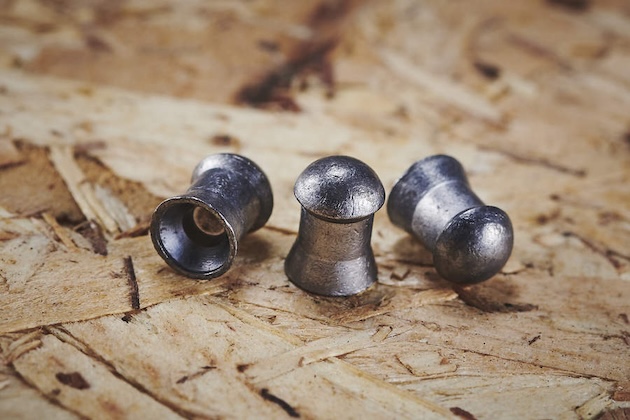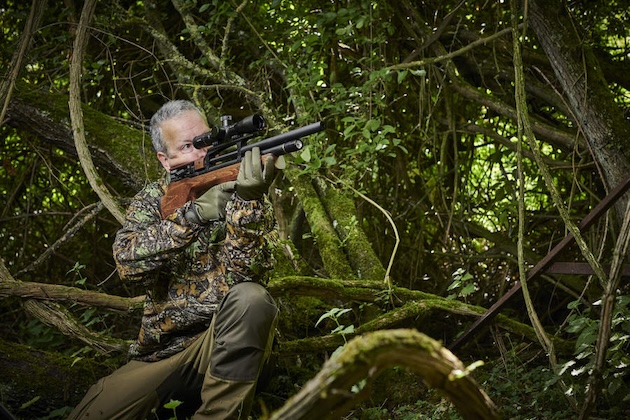Modern airguns are quite capable of dealing with vermin and small game up to the size of rabbits. They will be sure to improve your rifle marksmanship too, advises Mike Yardley.
Modern Airguns
Airguns have become much more sophisticated in recent years. Though accurate and quite powerful shooting tools, they do not carry the licensing hassles of conventional firearms (unless you live in Northern Ireland and Scotland) provided they are under the 12ft-lb power limit (6ft-lb for pistols).
Modern airguns and vermin
Most modern airguns are quite capable of dealing with vermin and small game up to the size of rabbits at up to 35yd, even 40yd (my suggested limit for their sensible use). They are a great way to improve your rifle marksmanship as well. One serious point before going further, however. Airguns must be treated with the same care and respect as any other gun – they can still inflict terrible injury and may even kill. Not having a loud report does not mean that they are toys. Far from it. But they do not fire projectiles that carry vast distances (whereas a .22 rimfire bullet may travel a mile if shot unwisely). (Read: how Britain became a world leader in airgun development.)
Useful for confined spaces
Airguns – often the implement of choice for professional vermin controllers – are the ideal option for confined spaces such as gardens, cellars, barns, paddocks and similar. They are popular tools for field “hunting” of small game, too: squirrels, rabbits, rats and pigeon all fall regularly to both spring-powered and pneumatic (compressed-air) guns. The former have the advantage of being self-contained, the latter usually require some sort of external pump or air cylinder to charge them up. They have the advantage, however, of having no recoil or vibration on firing and are inherently, even in cheaper form, accurate (especially when equipped with a telescopic sight).
Spring-powered air rifles
Modern “springers” (which may in their most evolved form have a gas ram instead of the conventional piston and helical spring) are still extremely accurate and, with synthetic seals rather than the old leather type, remain in good shooting condition and more consistently powerful with less maintenance than their ancestors. They, too, are much improved with a shooting optic and, like the pneumatic guns, may be equipped with a sound-moderator, too.
Like many readers, I suspect, I used an air rifle as a boy. My first was a
Webley Junior .177. There followed a Daisy lever-action bb “Winchester” and matching and, happily, under-powered, Peacemaker bb pistol.
I aspired to and eventually reached the dizzy heights of an Original model 50 and a .22 BSA Airsporter. I even managed to acquire some vintage Lincoln Jeffries in my teens and they still work remarkably well today, leather seals or not.
Airgun laws
Airguns are an excellent and economic route to learning safe gun handling habits. Under 14 years individuals can use an air rifle under supervision on private premises with the supervisor being at least 21 years old. However it is illegal to sell an air rifle or ammunition to a person under 18 years of age.
From the age of 14 to 17 a young person may borrow and use use an airgun unsupervised provided he or she has the permission of the landowner.
Pellets must not stray beyond the boundaries of your land or the land you have permission to shoot on (unless you have authorisation from the neighbouring landowner).
What to buy?
Here are some of the best, in my opinion.
Weihrauch HW 100. The Rolls-Royce of modern sporting airguns. I had one but, unwisely, sold it to a friend who was equally impressed. A pre-charged pneumatic, it has an unusual but effective short side-lever which loads it via a 14-shot rotary magazine. The build quality is superb. One may have a conventional or thumb-hole stock, and it is uncannily accurate shot after shot (and whisper-quiet thanks to a sound moderator). It’s a fantastically good gun. HW also makes the break-action HW95 and the underlever HW97. Both are excellent, but the HW100 is in a class of its own.
Air Arms S410 This has been around a long time. It is universally popular, setting an industry standard (the Beretta Silver Pigeon of the airgun world). It has a bolt action and a conventionally shaped wooden stock. The magazine holds 10 shots, the trigger is good and the gun generally reliable. This, too, is of pre-charged pneumatic design and will therefore need filling from an external bottle or by means of a specialist stirrup pump. It is absolutely recoilless and extremely accurate. It is also available in take-down version with a skeleton stock packed in an attaché case that may be discreetly carried in the boot – very James Bond (and a perfect present for the man who does not quite have everything).
Daystate Air Ranger Another especially good pre-charged pneumatic design. It may be equipped with a 10-shot magazine or a single-shot loading tray. Like the S410, it has a great (adjustable) trigger pull (essential for accuracy in any air weapon), good build quality and a shrouded barrel, which has a silencing effect. You may add a dedicated carbon-fibre sound moderator as well, which barely affects the balance. The walnut thumb-hole stock is ergonomically efficient, looks good and has a cheek-piece usable by right-and left-handers (you may have a plastic stock if you prefer).
Air Arms S200 This is a quality gun – another pre-charged pneumatic – at a budget price and made for Air Arms in the Czech Republic by CZ. I have one and it is an excellent piece of kit, lightweight and far more accurate than it deserves to be at the price. It is a single-shot design. A magazine and sound moderator are retro-fit options. The stock – indeed the whole gun – is well suited to use by young people (though adults may be happy to shoot with it, too).
FX Verminator This has the distinction of being the favourite all-purpose gun of my friend, the airgun guru, renowned airgun hunter and character Terry Doe. It is both pneumatic and take down. “The Verminator can go anywhere. It’s the ultimate in discreet performance. It’s as accurate as a match rifle, near silent and very reliable; stylistically, it looks unique,” he says. If Terry likes it, you may be sure it is special. This is another one that would not look out of place in a Bond film and might go on the “unusual but welcome” present list.
BSA R-10 Mk 2 This is the flagship gun from a great old British maker. There were some issues with the Mk 1 version but these have been fully addressed. With 20-odd design changes, this is another modern classic. It feels solid and has a good stock (with an attractive rosewood fore-end cap). The trigger is adjustable for all sorts of things, including second-stage length. The balance is especially good and the shrouded barrel allows for the use of a silencer. BSA also makes the shorter and lighter Scorpion carbine, another good gun (and good value), and the XL, which is a conventional springer.
Well, that is my top six, but I shall sneak in one more gun for consideration: the well-priced Crosman Nitro Venom Gas Ram. It is not quite in the same category as the others mentioned, but nor is the price. It uses a gas ram and is smoother to shoot as a result.

What about airgun pellets?
All of the guns mentioned are only as good as the pellets you put in them, so do not skimp. There is wide variation in price (for a reason). I recommend H&N, RWS, Daystate, Air Arms and Crosman Premier pellets. All should group well under an inch at 40yd with a good gun.
When you have bought your airgun you will need to zero it carefully and familiarise yourself with the trajectory (the secret of airgunning, apart from a solid hold and careful triggering).
Zero is best established at 12yd initially. Assuming you have the modern standard 3-9×40 telescopic sight attached, the 12yd zero with .22 pellets should be bang on again at 27yd or thereabouts and 3⁄4in or so high at 20yd. At 30yd expect to be 1⁄2in low, 1in at 35yd and 2in at 40yd. With a .177, which many experienced airgunners prefer for its flatter trajectory, expect the 12yd zero to be on again at 30yd to 35yd, 1⁄2in high at 20yd and 1⁄2in low at 40yd.
This article was originally published in 2012 and has been updated.





